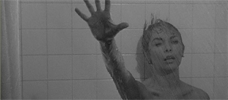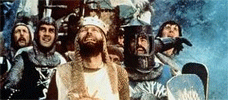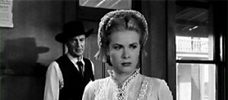Reviews
Terry Jones
UK, 1975
Credits
Review by Sam Bett and Glenn Heath Jr.
Posted on 02 February 2011
Source Sony DVD
Categories Blind Spots
I warned you, but did you listen to me? Oh, no, you knew, didn’t you? Oh, it’s just a harmless little bunny, isn’t it?
Introduction by Sam Bett
Monty Python and the Holy Grail was one of the first comedy films intended for adults that I ever saw. I was no older than eight, and still young enough that my presumptions about what was funny were still impressionable and amorphous. Monty Python solidified them. This comedy troupe’s absurd, irreverent style became the standard against which I judged all comedy I’ve seen since, and Holy Grail was the film that first exposed me to their trademark brand of sardonic wit.
In Holy Grail nothing is sacred, but British history and popular film conventions receive the most thorough roasting. King Arthur, the lionized monarch of England’s past, is portrayed by Graham Chapman as a British Don Quixote who trots along the countryside (without a horse) in search of knights to join him in his quest for the elusive Grail. Throughout his journey, nearly every serious moment is subject to ridicule. The armed duel, a highly formal affair among the chivalrous, is rendered absurd through King Arthur’s bout with the Black Knight, who calls the battle “a draw” only after losing all four limbs. A brief sequence mocking the dry delivery of British historical documentaries ends abruptly when a “famous historian” is felled and slain by a blindly charging knight. The sense of historical authority the film attains through filming on-location at real British castles is undermined when King Arthur and his men arrive at Castle Camelot, only for the squire Patsy to confess, “It’s only a model.” Even the credits that open the film hold no safe ground, and are tormented by subtitles written in the voice of what appears to be a mock-Swedish travel agent who encourages viewers to “try a høliday in Sweden” and “see the løveil lakes.”
Despite its consistent lack of seriousness, Holy Grail is meticulously researched and intellectually rendered. The monks who chant “Pie Ieusu Domine” as they march through the filthy medieval streets and flagellate themselves with cross-emblazoned planks are speaking real Latin: “Merciful Lord Jesus.” The castles, as mentioned above, are not sets (apart from Camelot) but genuine British structures, although many of them are inexplicably occupied by offensive French soldiers. The film is also superbly acted, with the half-dozen Python players assuming multiple roles throughout the film and sometimes within the same scene, such as Terry Gilliam’s appearance as both Patsy and The Bridgekeeper at the Bridge of Death scene, and John Cleese’s portrayal of both the most vocal of the taunting French soldiers and Sir Lancelot when Arthur’s band encounters their first French-occupied castle. The film was also cooperatively written and produced by Monty Python members themselves, with all six members contributing as credited writers and Terry Gilliam and Terry Jones co-directing the feature. Even the medievalesque animation sequences were produced by Python Terry Gilliam, who appears briefly in the film as The Animator, who falls backwards in his chair in fast-motion when a “fatal heart attack” kills him just before an giant animated monster can consume Arthur’s band of knights.
As professional satirists, Monty Python understood that for irreverent humor to be sound and effective, one must thoroughly understand one’s target. The outrageous accents, costumes, and ornately adorned sets are only some of the details to which Monty Python attended to meticulously, executing the intense care and compassion that distinguishes satire which is insulting from that which is artful and even complementary.
Holy Grail is crafted in a savvy, self-conscious style that was well before its time, and has stood the test of our own critical era. While perhaps not the best date movie (trust me), it deserves a chance from anyone interested in comedy (which should be everyone). You may find yourself watching it more than once, challenging the French soldiers who harass Arthur and warn him, “Now go away before I taunt you a second time.”
Review by Glenn Heath Jr.
Despite spending most of my life engrossed in the viewing and study of films, I have never considered myself a movie quote guy. The point of rehashing the same lines over and over again always struck me as odd, especially in high school when many friends relied on their knack for clever references to address the virtues of certain films rather than any variation of concrete analysis. At worst, these quoting sessions seemed like a form of bragging or arrogance that had nothing to do with the value of the film being remembered. As these groups mused on subjects I wasn’t familiar with, like the latest high jinks on David Letterman, the ironic ramblings of a Seinfeld episode, or the repetitive verbal color of The Big Lebowski (albeit before I discovered its genius), I often felt like an outsider. The isolation of being left out of an in-joke weighs heavily on even the most passionate and confident cinephile.
If there was one example that defined my social unease it was Monty Python and the Holy Grail, a film that seemingly everyone could quote but me. It’s impossible to fathom how many times I heard, “I fart in your general direction” or “It’s but a flesh wound,” and after a while I started to resent even the casual mention of Holy Grail. The uncomfortable ubiquity of these catch phrases was probably the reason that at the age of 29, I still hadn’t seen one Monty Python film or episode of television, arguably one of the most popular and influential comedy franchises ever. Calling this a glaring gap of film spectatorship would be an understatement, one intrinsically linked to my personal bias and sour memories rather than the film itself. So for this feature on “Blind Spots,” I couldn’t think of a better choice than Terry Gilliam and Terry Jones’ absurd spoof on the King Arthur legend. It was high time I put my past to rest and found out what all the fuss was about.
The playful anarchic tone of Holy Grail is immediately evident when the opening sequence of a black-and-white film entitled Dentist on the Job plays instead of the Python picture. After a few minutes of swift working class imagery, the frame cuts to black and the sound of a grouchy coughing projectionist infers a technical snafu. It’s a brilliant coup of referential filmmaking, as Jones and Gilliam not only connect their film with the long history of British comedy, but also position it as the next evolutionary step in the genre process. The following booming musical score segues into the “seriousness” of medieval England, circa 932 AD, and the icon King Arthur traverses the countryside riding an imaginary horse, his manservant making the sound of clacking hooves by smacking two coconuts together. The absurdity of Arthur’s actions is called into question when a castle guard confronts the pair about their preferred mode of transportation. The conversation descends into repetitive chaos, and the entitled earnestness of Arthur and the snarky irony of the guard introduce the core form of banter that will come to define Holy Grail’s keen wit and commentary on the class system in England, both past and present. The workingman and royal snob will battle for religious and economic supremacy throughout.
Arthur’s aimless journey gains a bit more structure after God orders him to find the Holy Grail, hollering down from the heavens via some hilariously crummy animation. But Jones and Gilliam pummel any notion of heroism and momentum by constantly shifting perspectives between Arthur, and his legion of bumbling knights that include Sir Lancelot, Galahad, Robin, and Bedevere. This motley crew of dimwits and aggressors splits up to find the grail, splintering off into the many fantastical realms the countryside has to offer. Witches, both real and imagined, giants, and annoyingly smart French soldiers all challenge the mythology of Arthur’s strength and his potency as a leader. This tangential focus grows stronger and more brutal as the film progresses, coming to a head when Lancelot charges a castle to save a supposed maiden from marrying an evil man. As Lancelot slices his way through the innocent wedding party, spewing blood and limbs all over the stone façade, it’s hard to not be disturbed by the mass violence. The maiden in distress turns out to be a meek, blushing man looking for a hero to rescue him from a tortured life of heterosexuality. Ah, the irony.
While the myriad of funny quips keep Holy Grail churning (my favorite being “Are you suggesting coconuts migrate?”), the thematic/critical commentaries on English mythology and history elevate the film’s importance as satire. Arthur’s quest is about a fundamental, unthinking desire to find religious affirmation no matter the public cost, and the peasants watching from the periphery often question the devastating inanity. In the film’s most telling moment, Arthur stops to ask two filthy yet politically savvy vagabonds covered in feces for information about the occupant of the local castle. Amidst the conversation on different modes of communal hierarchies, one serf says to the other, “He must be a king… he hasn’t got shit all over him.” Arthur’s denseness, the peasant’s slyness, and the biting reality of the contrasting social experiences add up to a deafening creed on the fluctuating layers of power in England’s widening class divide.
Holy Grail continues to skewer the elitism of historical revisionism by juxtaposing the haplessness of its “heroes” with the surprising violence of nature (the killer rabbit), the ludicrousness of religious symbols (the Holy Grenade), and the improvisational power of magic (best displayed by the Tim “The Enchanter” character). But the subversive narrative pacing connecting the Arthur legend with twentieth century realities becomes the film’s most indelible offering to post-modern comedy. Midway through the film, Jones and Gilliam introduce “a famous historian” to narrate the film, and the elderly scholar’s words are abruptly silenced by a swipe of a galloping knight’s sword. As the academic’s wife runs up stunned and modern police constables arrive to investigate the crime, there’s a sense this act of violence will come to haunt Arthur and his cut-happy knights later in the film. And in the final moments, the consequences of this event do come full circle. As Arthur and his legion charge the French fort to acquire the grail, their assault gets cut off by a squadron of cops who swoop in and arrest the lot of them for the murder. Arthur’s brutal and costly crusade is stunted, denied by the present-day ramifications of his actions, and religious sanctity remains an unquenched fantasy.
With some distance, I can see exactly why my teenage friends focused almost entirely on Holy Grail’s lines of juvenile bliss to prove their undying devotion for this canonical film. The surface comedy makes such an impact it’s easy get caught up in the irony of the Python exterior, but the lasting virtues of Holy Grail reside in the reality of mass desperation festering underneath the muck, bog, blood, and shit. This is a brilliantly angry film from a comedy group smart enough to mask their rage with layers of awkward and ironic historiography. Quoting a film might only refer to a momentary joy that’s skin deep, but this practice invariably calls attention to the lasting impact of a film on large groups of viewers. Instead of seeing quotidian quoting as a pejorative, it’s important to see the act as a billboard for zeitgeist films more worthy of attention, despite any sourpuss memories the viewer brings to the table. I guess for every personal victory of spectatorship there’s a growing realization that critics and pundits aren’t always as smart as we think. As the limbless Black Knight says, “we’ll call it a draw.”
More Blind Spots
-

Pee-wee’s Big Adventure
1985 -

The Matrix
1999 -

Amélie
2001 -

The Breakfast Club
1985 -

Psycho
1960 -

Blade Runner
1982 -

Chinatown
1974 -

Monty Python and the Holy Grail
1975 -

Rocky
1976 -

High Noon
1952 -

Ferris Bueller’s Day Off
1986 -

Taxi Driver
1976 -

The Godfather
1972 -

E.T.
1982 -

Pulp Fiction
1994
We don’t do comments anymore, but you may contact us here or find us on Twitter or Facebook.



